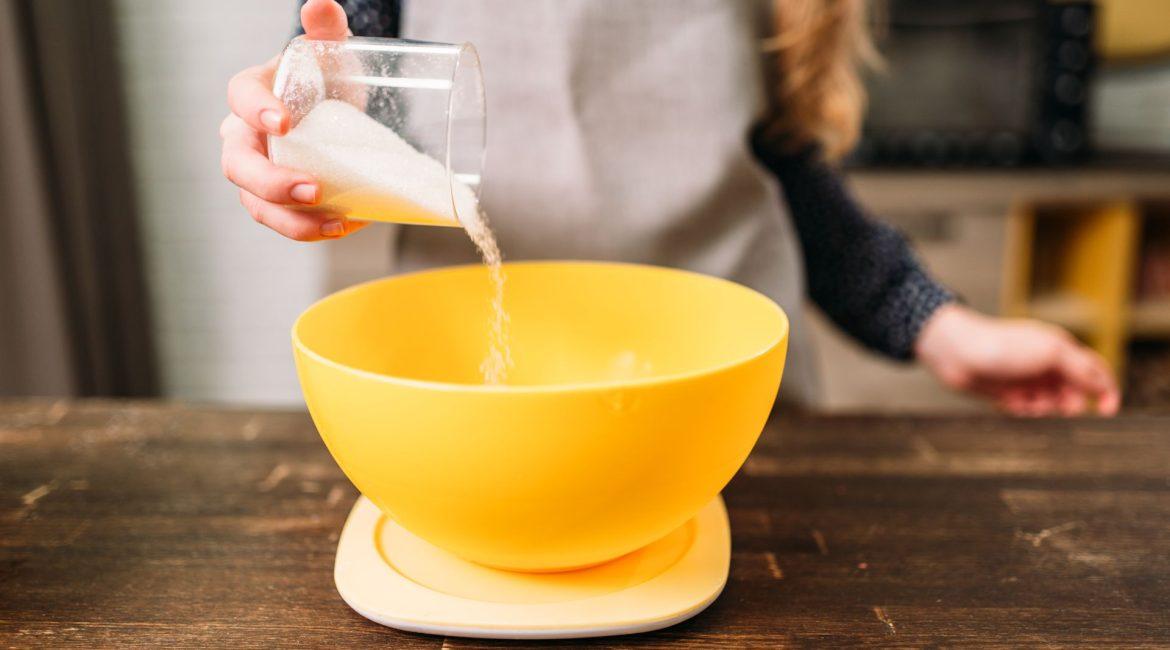Today, we’re diving into the sweet science of making the perfect chocolate chip cookies. And it all starts with one crucial ingredient sugar.
Join us as we explore when and how to add sugar to your cookie dough for irresistible, chewy, and golden-brown cookies that are sure to delight your taste buds. Let’s get baking.
The Perfect Balance: Timing Sugar Addition for Chocolate Cookie Perfection.
You should add sugar to your chocolate cookie dough during the early stages of mixing the ingredients.
Adding sugar to your chocolate cookie dough during the early stages of mixing the ingredients, particularly during the creaming step with butter, is essential for several important reasons.
Here are some reasons why important:
Texture and Consistency: Sugar plays a significant role in the texture and consistency of cookies.
During the creaming process, when sugar is beaten with softened butter, it creates small pockets of air.
These air pockets get trapped in the fat and sugar mixture, resulting in a light and fluffy texture. This aeration helps give your cookies a soft, tender, and slightly chewy interior.
Flavor Development: Sugar contributes sweetness to the cookie dough, enhancing its overall flavor.
Creaming sugar with butter not only incorporates air but also allows the sugar crystals to dissolve partially in the fat.
This partial dissolution helps evenly distribute the sweetness throughout the dough, ensuring that every bite of the cookie is sweet and delicious.
Moisture Retention: Sugar is hygroscopic, meaning it attracts and retains moisture.
When you add sugar early in the mixing process, it helps the cookies retain moisture during baking.
This moisture retention prevents the cookies from becoming overly dry or crumbly and contributes to a moist, tender interior.

Spread and Shape: The sugar in the dough affects the spread and shape of your cookies during baking.
By creaming the sugar with butter, you create a mixture that is easier to work with and allows for better control of cookie shape.
This is particularly important if you want your cookies to maintain their intended size and shape as they bake.
Caramelization and Browning: Sugar is a key contributor to the browning and caramelization of cookies.
During baking, the sugar in the dough caramelizes, creating a golden-brown exterior and adding depth of flavor.
This caramelization process is responsible for the desirable crispy edges and soft centers that many people enjoy in chocolate chip cookies.
In other words, adding sugar early in the mixing process, especially during creaming with butter, is crucial for achieving the desired texture, flavor, and appearance of your chocolate cookies.
It creates a light and fluffy texture, evenly distributes sweetness, retains moisture, influences cookie spread and shape, and contributes to browning and caramelization during baking, all of which are essential for creating delicious chocolate cookies.
Let’s delve deeper, let me explain these points mentioned further here.
Firstly, let’s delve deeper into how sugar affects the texture and flavor of cookies during the creaming process:
Texture and Consistency.
Aeration:
During the creaming process, when sugar is mixed with softened butter, the sugar crystals act as tiny abrasive particles.
As the mixer beats the sugar and butter together, these crystals create friction against the fat (butter), causing it to soften and become pliable.
Trapped Air:
The friction generated by the sugar crystals also incorporates air into the mixture.
This is a crucial step in achieving a light and fluffy texture in cookies.
The air gets trapped within the fat and sugar matrix, creating small pockets of air throughout the dough.
Leavening Effect:
The incorporation of air during creaming acts as a leavening agent.
When the cookies are baked, the trapped air expands due to the heat, causing the cookies to rise and puff up slightly.
This contributes to the soft, tender, and slightly chewy interior that many people desire in their cookies.
Flavor Development.
Sweetness:
Sugar is, of course, responsible for the sweetness in cookies. As sugar is creamed with butter, the sugar crystals partially dissolve in the fat.
This dissolution process helps evenly distribute the sweetness throughout the dough, ensuring that every part of the cookie is sweetened.
Flavor Enhancement:
Sugar not only adds sweetness but also enhances the overall flavor profile of the cookies. It acts as a flavor enhancer, making the other ingredients, such as chocolate, vanilla, and salt, taste more pronounced and balanced.
Caramelization:
During baking, sugar caramelizes, creating a complex, rich, and slightly nutty flavor.
This caramelization process occurs more readily due to the even distribution of sugar in the dough, resulting in the desirable depth of flavor and golden-brown appearance of well-made cookies.
In essence, the creaming of sugar with softened butter in cookie dough serves a dual purpose.
It not only contributes to the light and fluffy texture of cookies by incorporating air but also evenly distributes sweetness and enhances the overall flavor profile of the cookies.
These combined effects create the signature soft, tender, sweet, and delicious qualities that we associate with well-baked cookies, especially chocolate chip cookies.
Let’s explore how sugar affects moisture retention, spread, and shape of cookies when added early in the mixing process:
Moisture Retention.
Hygroscopic Nature of Sugar:
Sugar is hygroscopic, which means it has the ability to attract and hold onto moisture from the surrounding environment.
When sugar is added early in the mixing process and creamed with butter, it begins to interact with the other ingredients, including any liquid components like eggs.
Preventing Dryness:
This interaction helps to bind and retain moisture within the cookie dough.
As the cookies bake in the oven, the sugar holds onto moisture, preventing the cookies from becoming overly dry or crumbly.
This moisture retention is essential for achieving a moist, tender interior in your cookies.

Spread and Shape.
Consistent Texture:
Creaming sugar with softened butter creates a uniform, smooth mixture.
This consistency is important for even cookie dough distribution and ensures that each cookie will have a similar texture.
Butter-Sugar Emulsion:
The creamed mixture of sugar and butter forms an emulsion where the fat (butter) is dispersed evenly throughout the sugar.
This emulsified mixture is easier to work with and provides better control over the final shape and texture of the cookies.
Controlled Spread:
When you place cookie dough on a baking sheet, the sugar in the dough starts to melt and caramelize during baking.
This caramelization process, driven by the heat in the oven, causes the cookies to spread.
By having the sugar evenly distributed and integrated into the dough, you can achieve a more controlled and consistent spread.
Maintaining Shape:
If you want your cookies to maintain their intended size and shape as they bake, the even distribution of sugar is essential.
It prevents excessive spreading or irregular shapes, allowing you to create cookies with a uniform appearance.
In other words, adding sugar early in the mixing process, especially during creaming with butter, has a significant impact on the moisture retention, spread, and shape of cookies.
It helps keep the cookies moist and tender by holding onto moisture, and it ensures that the cookies maintain their intended shape and texture during baking, leading to a more consistent and visually appealing final product.
Caramelization and Browning
Sugar is a crucial element when it comes to the caramelization and browning of cookies during baking.
Here’s a more detailed explanation of this process and its impact on the texture and flavor of chocolate chip cookies:
Caramelization and Browning:
Maillard Reaction:
When cookies bake in the oven, the sugar in the dough undergoes a complex chemical reaction known as the Maillard reaction.
This reaction occurs when sugars and proteins in the cookie dough interact under high heat, typically above 300°F (150°C).
Caramelization:
As part of the Maillard reaction, the sugar molecules break down and undergo caramelization. This process involves the sugar molecules transforming into various flavorful compounds, producing a rich, caramel-like taste and aroma.
Golden-Brown Exterior:
Caramelization is responsible for the appealing golden-brown color that develops on the exterior of the cookies.
This browning not only enhances the visual appeal but also contributes to the depth of flavor.
Texture Contrast:
The Maillard reaction and caramelization create a pleasing textural contrast in cookies.
The exterior of the cookies becomes crispy and slightly crunchy due to the caramelization, while the interior remains soft and chewy.
This contrast between the crispy edges and soft centers is a hallmark of well-made chocolate chip cookies and is highly sought after by many cookie enthusiasts.
Flavor Enhancement:
Beyond the color and texture, caramelization also adds complexity and depth to the flavor profile of the cookies.
The presence of caramelized sugars imparts a subtle nuttiness and a deeper sweetness, making the cookies more enjoyable and satisfying.
In summary, the sugar in cookie dough plays a pivotal role in the caramelization and browning process during baking.
This process not only enhances the visual appeal of the cookies but also contributes to their flavor and texture.
The combination of a golden-brown exterior, crispy edges, and soft, chewy centers is what makes chocolate chip cookies so irresistible to many people, and sugar is a key contributor to this delightful outcome.
Here’s a more detailed step-by-step process to get your chocolate cookie done:
Gather your ingredients:
Before you start mixing, make sure you have all your ingredients measured and ready.
For chocolate cookies, you’ll typically need sugar, flour, cocoa powder, baking soda, salt, butter, eggs, and chocolate chips or chunks.
Cream the butter and sugar:
In a mixing bowl, combine your softened butter (usually at room temperature) and the sugar.
The ratio of sugar to butter can vary depending on your recipe, but a common ratio is about 1 cup of sugar to 1 cup of butter.
Creaming involves beating the butter and sugar together until the mixture becomes light and fluffy. This helps to incorporate air into the dough, resulting in a softer and more tender cookie.
Add eggs and vanilla extract:
Once the butter and sugar are well creamed, add your eggs one at a time, mixing well after each addition.
Also, add vanilla extract for flavor. Mixing the eggs and vanilla into the creamed butter and sugar ensures even distribution of these ingredients.
Combine dry ingredients:
In a separate bowl, whisk together your dry ingredients, such as flour, cocoa powder, baking soda, and salt.
This step helps evenly distribute the leavening agents and cocoa powder, ensuring a consistent texture and flavor throughout the dough.
Gradually add dry ingredients:
With your mixer on low speed, gradually add the dry ingredients to the wet mixture. Mix until just combined.
Overmixing at this stage can lead to tough cookies, so be careful not to overdo it.
Add chocolate chips or chunks:
If your recipe calls for chocolate chips or chunks, fold them into the dough with a spatula or mixer on low speed.
This should be done after the dry ingredients are fully incorporated to avoid overmixing the chocolate.
Chill the dough (optional):
Some recipes recommend chilling the cookie dough for a few hours or overnight in the refrigerator.
This helps the flavors meld and can prevent excessive spreading during baking.
Shape and bake:
After chilling (if applicable), scoop or shape the cookie dough onto a baking sheet and bake according to your recipe’s instructions.
By adding sugar during the creaming process, you ensure that it’s evenly distributed throughout the dough, resulting in a deliciously sweet and well-balanced chocolate cookie.
A tabular on this topic here.
Here’s a tabular representation of when you should add sugar to your chocolate cookie dough:
| Stage in Cookie Making Process | When to Add Sugar to Chocolate Cookie Dough |
|---|---|
| 1. Gather Ingredients | Before you start mixing, ensure you have all your ingredients measured and ready, including sugar. |
| 2. Cream the Butter and Sugar | Add sugar to softened butter at the beginning of the mixing process. Creaming sugar with butter creates a light and fluffy texture. |
| 3. Add Eggs and Vanilla Extract | After creaming the butter and sugar, add eggs one at a time, along with vanilla extract. Mix well after each addition. |
| 4. Combine Dry Ingredients | In a separate bowl, whisk together dry ingredients such as flour, cocoa powder, baking soda, and salt. |
| 5. Gradually Add Dry Ingredients | With the mixer on low speed, gradually add the dry ingredient mixture to the wet mixture (butter, sugar, eggs, and vanilla). Mix until just combined. |
| 6. Add Chocolate Chips or Chunks | If your recipe includes chocolate chips or chunks, fold them into the dough after the dry ingredients are fully incorporated. |
| 7. Chill the Dough (Optional) | Some recipes recommend chilling the cookie dough in the refrigerator for a few hours or overnight. This step enhances flavor and texture and can be done after sugar is added. |
| 8. Shape and Bake | Scoop or shape the cookie dough onto a baking sheet and bake according to your recipe’s instructions. The sugar in the dough contributes to browning and caramelization during baking. |
This table outlines the step-by-step process of adding sugar to your chocolate cookie dough, ensuring that you maintain the desired texture, flavor, and appearance of your cookies.
Conclusion.
In conclusion, adding sugar to your chocolate cookie dough during the creaming process with softened butter is a crucial step that influences the texture, flavor, and appearance of your cookies.
Sugar contributes to a light and fluffy texture, even sweetness distribution, moisture retention, controlled spread and shape, and the desirable caramelization and browning during baking.
Mastering the timing of sugar incorporation is key to achieving delicious, well-balanced chocolate chip cookies.

Whether you’re a passionate baker or simply seeking sweet inspiration, I’m here to provide you with valuable insights, mouthwatering recipes, expert tips, and more to make your cookie adventures with Mike truly delightful and scrumptious. You are on the true exciting cookie-filled side.




